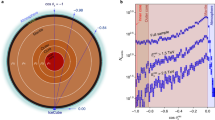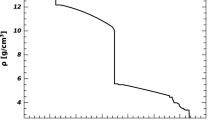Abstract
The neutrino experiment IceCube at South pole can distinguish between Bulk Silicate Earth model and Hydridic Earth model predictions about inner Earth density by using neutrino absorption tomography. The result can be obtained during less than 10 years of operation. The experiment PINGU at South pole can check the Hydridic Earth model predictions about Earth core electron density by using neutrino oscillation tomography. The result will be obtained for the time of operation much shorter than 10 years. The combination of IceCube and PINGU results will give the information about the Earth core chemical element composition.
Similar content being viewed by others
References
W. Winter, “Neutrino tomography—Learning about Earth’s interior using the proparation of neutrinos,” arXiv:physics/0602049v2[physics.geo-ph].
C. Rott, A. Taketa, and D. Bose, “Spectrometry of the Earth using neutrino oscillations,” arXiv:1502.04930v1[physics.geo-ph]17 Feb 2015.
F. Mantovani, L. Garmignani, G. Fiorentini, and M. Lissia, “Antineutrino from Earth: A reference model and its uncertainties,” arXiv:hep-ph/030913v2, 27 November 2003.
L. Bezrukov, “Geoneutrino and hydridic Earth mode,” Version2. Preprint INR 1378/2014. M., 2014; arXiv:1308.4163[astro-ph.EP].
V. N. Larin, “Hydridic Earth: The new geology of our primordially hydrogen-rich planet,” Ed. by C. Warren Hunt (Polar Publishing, Calgary, Alberta, Canada, 1993).
H. Toulhoat, V. Beaumont, V. Zgonnik, N. Larin, and V. N. Larin, “Chemical differentiation of planets: A core issue”; arXiv:1208.2909 [astro-ph.EP]
L. Bezrukov and V. Sinev, “Geoneutrinos and hydridic Earth (or primordially hydrogen rich planet),” Phys. Part. Nucl. 46 (2), 182–185 (2015); arXiv:1405.3161[astro-ph.EP].
V. V. Sinev, L. B. Bezrukov, E. A. Litvinovich, et al., “Looking for atineutrino flux from 40K with large scintillator detector,” Phys. Part. Nucl. 46, (2) 186–189 (2015); arXiv:1405.3140V2[physics, ins-det].
J. Hansen, M. Sato, P. Kharecha, and K. von Schuckmann, “Earth’s energy imbalance,” Atmos. Chem. Phys. 11, 13421–13449 (2011).
M. Gonzalez-Garcia, F. Halzen, M. Maltoni, and H. Tanaka, “Radiography of the Earth’s core and mantle with atmospheric neutrinos,” Phys. Rev. Lett. 100, 061802 (2008); arXiv:0711.0745v2 [hep-ph] 19 Feb 2008.
M. G. Aartsen, R. Abbasi, M. Ackermann et al. (PINGU Collab.), “Letter of intent: The precision Ice- Cube next generation upgrade (PINGU),” arXiv: 1401.2046v1 [physics.geo-ph].
Author information
Authors and Affiliations
Corresponding author
Additional information
Talk at The International Workshop on Prospects of Particle Physics: “Neutrino Physics and Astrophysics” February 1–8, 2015, Valday, Russia.
The article is published in the original.
Rights and permissions
About this article
Cite this article
Bezrukov, L., Sinev, V. Atmospheric neutrinos for investigation of Earth interior. Phys. Part. Nuclei 47, 915–917 (2016). https://doi.org/10.1134/S106377961606006X
Published:
Issue Date:
DOI: https://doi.org/10.1134/S106377961606006X




